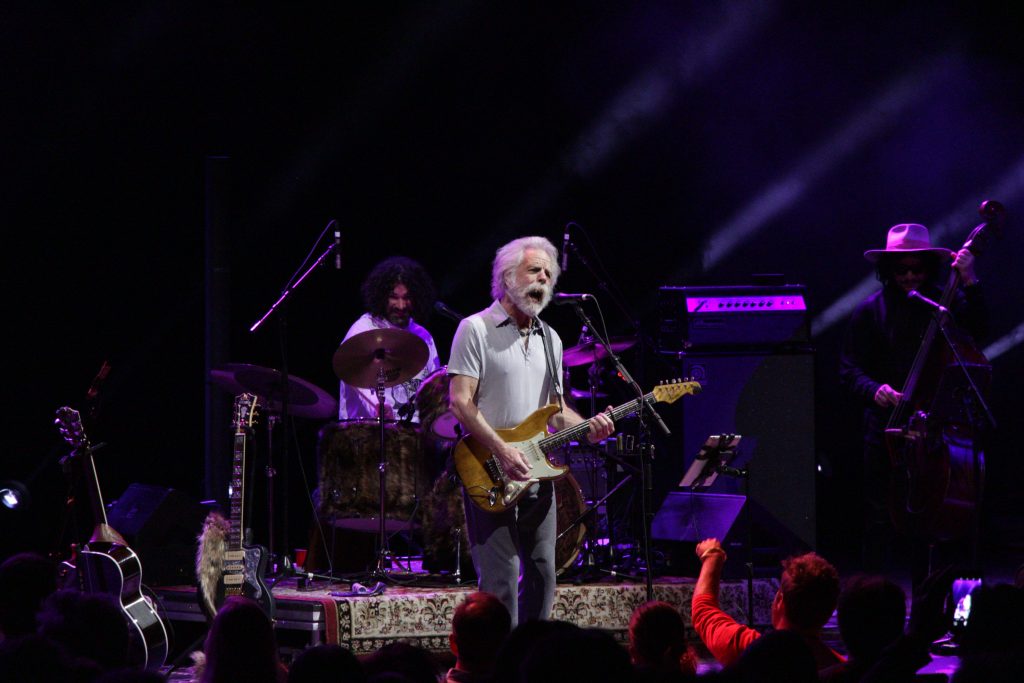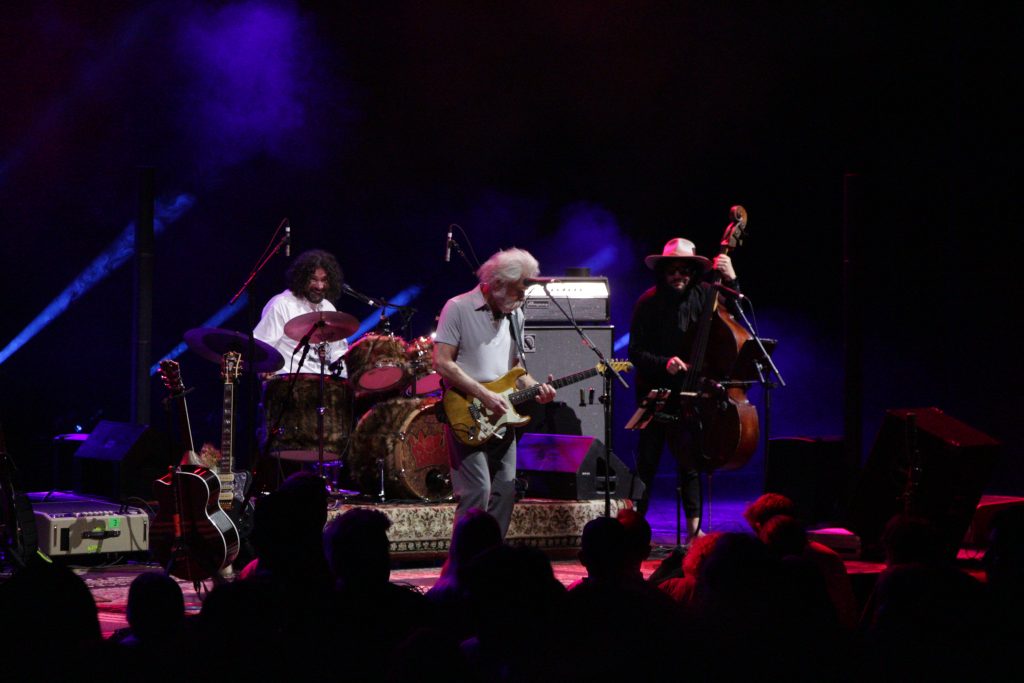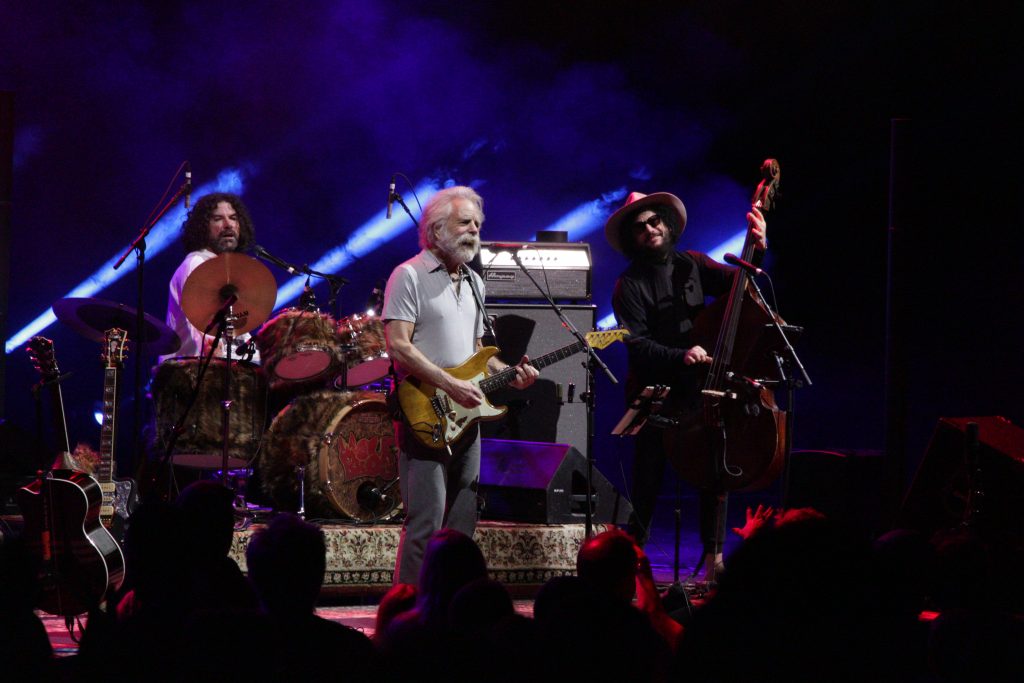REVIEW: Bob Weir @ Wang Theater 11/15

By Jordan Frankenthaler
The Grateful Dead was a big band. Often swelling to seven or eight members, the role of each musician was defined, though some would say unconventionally. Two contrasting drummers, Bill Kreutzman and Mickey Hart, provided concrete stability and a zany world influence, respectively. Phil Lesh was hardly a bassist. Frankly, he played “lead bass,” contributing to the melodic qualities of the band more than the rhythmic ones. Jerry Garcia needs no words, as none would adequately describe his essential role as lead guitarist in the band. And the rotating lineup of keyboard players defined the band’s different musical eras. Bob Weir played the often understated, often underutilized role of rhythm guitar.
That role has gained an unfortunate stigma: “Put a guitar in his hand so he can do something when he’s not singing” does not lend itself to frontman material. But don’t be fooled; Bob Weir is the Hendrix of rhythm guitar. In early Dead recordings, his playing and interplay with Garcia proves as important as Garcia’s soloing.
But that soloing is definitely necessary. It’s why the overwhelming majority of fans devoted their lives to seeing every Grateful Dead concert in the ‘80s and ‘90s, following the band from show to show. So when Weir announced he would be touring with a trio, I questioned if something would be missing from the sound. He essentially would be only bringing a rhythm section on tour: himself, a bassist, and a drummer. This lineup does not set itself up to be a “power trio” like those brought by Victor Wooten, Bill Evans, John Mayer, Oysterhead, Primus, or the musical core of Led Zeppelin (my definition of power trio is quite loose).
But the trio Weir assembled is not one to scoff at. Jay Lane (of Ratdog, Furthur and Primus fame) on drums and Don Was (producer of records by John Mayer, Elton John and Gregg Allman) on upright bass saw my confidence regained. If nothing else, Was and Lane promised a solid foundation for Weir. Ideally, the three would find cosmic synergy. This late in the tour (the fourth-to-last stop), one would hope that synergy was found most of the time.
And it was, though the shortcomings of Weir’s arrangement reared its ugly face at points.
The classic rocker “Hell in a Bucket” opened the show in energetic form, though the lack of lead guitar was especially pronounced. While I’m generally a fan of music that features fewer, well placed notes than more haphazardly ones, Weir stuck to his rhythm part for the majority of the song. As a fan and student of Weir’s playing, this was fascinating, but not exhilarating like many full band versions are.
The following “Good Morning Little Schoolgirl,” however, highlights what works with Wolf Bros. Weir switched to acoustic and performed the song in its truer blues standard arrangement, changing his sound from “arena rock” to “an intimate, acoustic evening,” per se. The simplicity of the piece allowed Weir to soar, even soloing for a bit.
The late-era Dead “Corrina” and Bob Dylan’s commonly-covered “Queen Jane Approximately” followed, both acoustic. An energetic Weir hollered his late original and took a gentler, tender approach to the playful Dylan tune.
The cowboy portion of the show followed, with Weir’s “Only a River” segueing neatly into Marty Robbins’s “El Paso.” “Only a River,” off Weir’s 2016 Blue Mountain, is an airy, ethereal tune that lingers in the air where it’s played. Though the album version garnered mixed reviews, the song shines live, with Lane’s harmonies adding extra gleam. The entire theater fell silent for the tune. The following “El Paso” fit in sound and content, with the somber cowboy tune perhaps describing a meeting between lovers in heaven. Both songs, of course acoustic, were the highlights of the set.
Returning to his electric guitar, Weir played a tune which I’d never heard, “Odessa.” A Ratdog staple, the funky southern groove got the house moving. That energy would not escape, with “Deal” closing the first set. Though again a lead guitar was glaringly not present (perhaps further highlighted by Weir taking vocal duty), Weir compensated with some appropriate fanning at the end.
A sloppy Bertha opened the second set, but we’ll ignore that in favor of the full Weather Report Suite which followed. The delicate Weir composition had been resurrected earlier in the tour at the Chicago Theater, and I’d been hoping to see it. Painfully absent from Weir’s catalog with previous solo acts and Dead and Company, the prelude and first part of the suite rang out aptly as “seasons change, and roses die” commemorated Boston’s first snow. The only improvement to be made would be the switch to acoustic, but I’ll happily take the full Suite in any form.
The following part two, “Let it Grow,” exhibited Weir’s jazz influence and the improvisational power of the band. Weir, Was, and Lane found that cosmic synergy and “let the music play the band.”
“He’s Gone” was also given room to breathe and segued into the most surprising song of the night, a cover of The Beatles’ “Tomorrow Never Knows.” Lane’s urgent drumming and Weir’s effects-laden tone had my mouth agape before the lyrics began.
The next pairing of “Ashes and Glass” and Garcia’s “Don’t Let Go” just made too much sense, as the two share a near identical melody. I’ve always been fond of “Don’t Let Go,” mid-70s JGB versions do great work for me, and this version, though shorter than those of JGB, too did good work.
There is a pseudo-revisionist movement in the Dead community which questions if late Garcia tunes are more owned by Weir than Garcia, because Weir has ended up singing the tunes for longer. Though there are good arguments on both sides, I’d like to think that it’s both, with Weir paying homage to Garcia by performing his death-imbued tunes. Regardless, “The Days Between” is the music of your soul. It’s crying and hope and triumph all rolled into one. Weir’s performance was raw and powerful, giving a tip of the hat to his late pal.
“Going Down the Road Feeling Bad” closed the set on a higher note, with a more delicate energy returning for Dylan’s “It’s All Over Now, Baby Blue.”
Ideally, a trio highlights the musical strengths and exposes the musical weaknesses of each member, for each musician is always highlighted. While Bob Weir’s weaknesses were definitely exposed, the reason we keep coming out to see these shows and this music too were exposed. Bob shined in the simple and delicate, stripping the sometimes-crowded stages he plays down to bare bones. In that act, he produced a meaningful set of crowd pleasers and deep cuts, linked by their genuineness and truth to the tradition of song.

